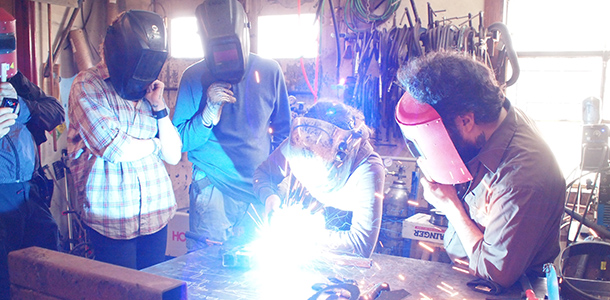
(Photo Credit: Becky Stern/Flickr)
The California Legislature yesterday passed a budget that includes an additional $200 million for a workforce training program that takes aim at the looming skills gap across the state's regions.
“This is a victory for both California employers and community college students. In our travels around California, we heard loud and clear about the need for more skilled workers in California,” said Van Ton-Quinlivan, vice chancellor for workforce and economic development at the California Community Colleges. “Enhancing career technical education and workforce training to meet the demands of our regional economies and the statewide labor market will benefit students, communities, and the entire state.”
When the California Economic Summit began its first regional meetings in 2012, the need for a qualified workforce was at the top of the list of ways to improve California's economy and preserve the state’s global status, now ranked 6th in the world by GDP.
Leaders from the California Economic Summit joined the 2015 Strong Workforce Task Force, a statewide effort led by the Community College Chancellor’s Office to upgrade California’s workforce training programs. It recommended more than two dozen improvements, which the Colleges Board of Governors adopted unanimously in November 2015.
The main areas covered in the recommendations are:
- Student Success
- Career Pathways
- Workforce Data and Outcomes
- Curriculum
- CTE Faculty
- Regional Coordination
- Funding
“The Strong Workforce Program requires the colleges to collaborate with each other and with the private and civic sectors. It directs resources to where they are needed and can do the most good, and over time rewards performance,” said Jim Mayer, California Forward’s CEO who served on the Task Force. “That's what employers wanted and students deserve — and it also is a governance model for the future.”
For a native Californian who worked his way up to the executive suite of a major U.S. employer, this investment is an important step toward recognizing the critical need employers in California and elsewhere are facing.
“Governor Brown and the California Legislature have done the right thing by making this investment in workforce training. Employers in California and across the country are in need of more middle-skills workers,” said Noel Massie, U.S. Operations Manager for UPS. “The next step is spending the money wisely to ensure that the community college students are learning skills that can help bridge this skill gap.”
Major employers are joined by smaller California employers who also see workforce training as a critical need. Now they are expecting results from the community colleges.
“As an employer of 75 people, one of my top challenges is finding and retaining qualified workers,” said Tom Mundy, owner of Superior Thread Rolling, a San Fernando Valley manufacturer of parts for the transportation industry. “What's important now is that the colleges make sure their curriculum reflects the latest in techniques so that students are adequately prepared for the job market.”
For the California Economic Summit, this increase in funding represents a major win. The Summit and its large network of civic and business leaders have been beating the drum for more investment in workforce education. Leaders sent a letter to legislators urging them to support the funding to support “a critical pathway for Californians seeking higher wages and jobs with a future.”
Sixty percent of the funding will go directly to the community colleges and 40 percent will be invested in regional consortia in which colleges and employers can work together to help identify ways to address unique needs in their regional economies.
“It's gratifying to know that the Governor and Legislature heard California employers when they said California must improve its pipeline of skilled workers and degrees,” said Alma Salazar, vice president of education and workforce development at the Los Angeles Area Chamber of Commerce and co-lead of the California Economic Summit Workforce Action Team. “It is imperative now that in each region of California we get various institutions working together to achieve a cradle-to-career emphasis in developing our workforce.”
The Legislature and the Summit are not done addressing the state's workforce gaps. More of the Strong Workforce Task Force recommendations are moving forward in separate bills, including funding for more financial aid to career technical education students (AB 1892) and how to improve how schools measure their success in student employment outcomes (SB 66).
Ensuring the Task Force’s recommendations result in more young people getting the skills they need and preparing more Californians for careers above minimum wage were top priorities in the Summit's action plan to produce one million more middle-skill workers over the next ten years.

